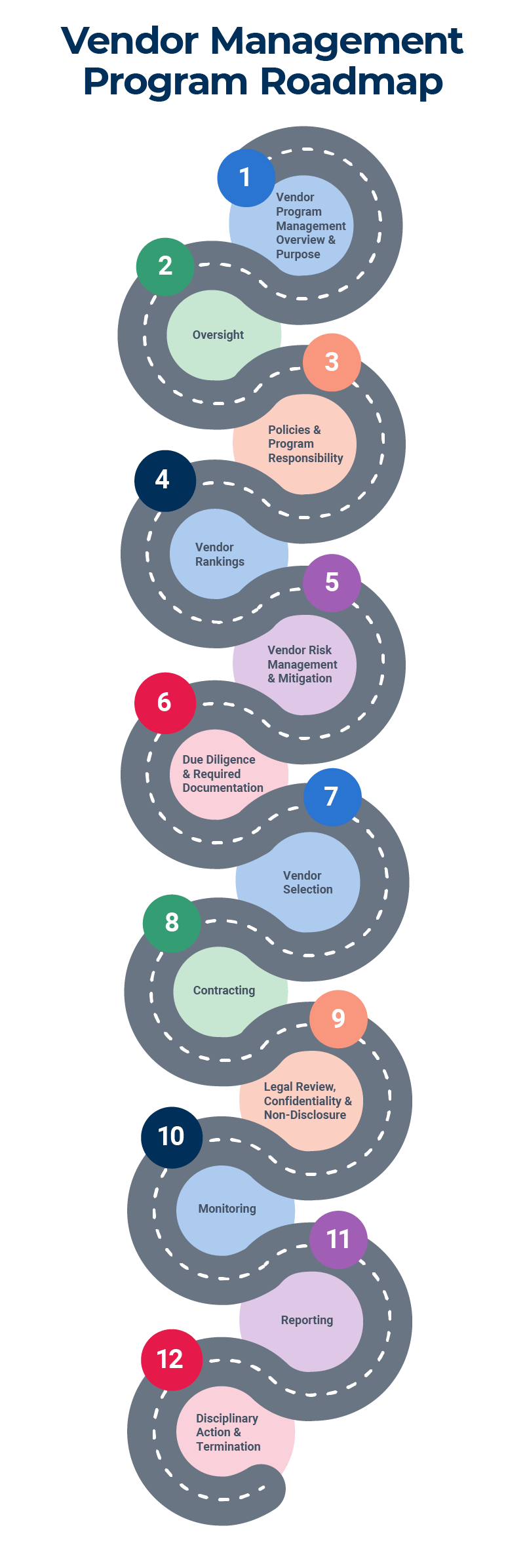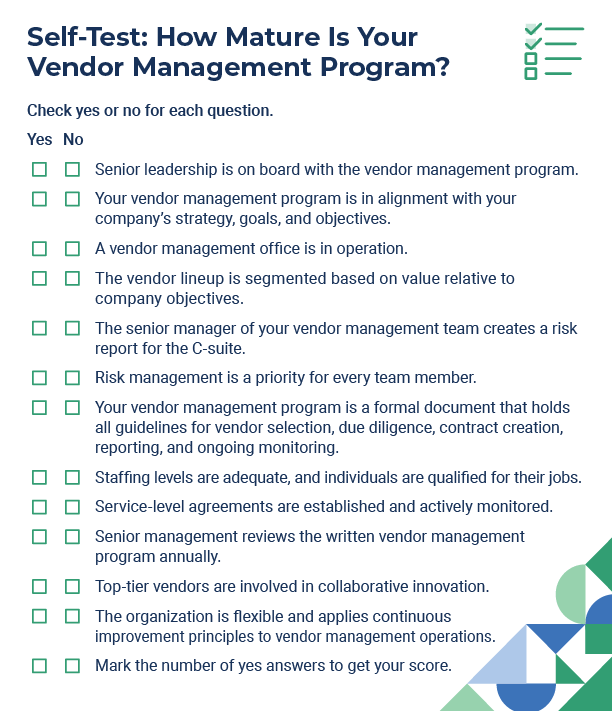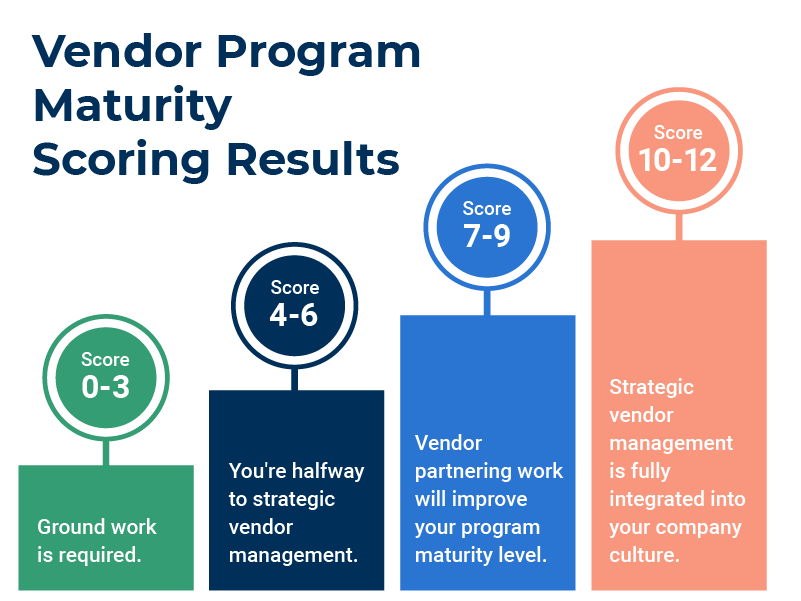What Is Vendor Management?
Vendor management, also called third-party vendor management, is how companies organize the way they buy goods and services. Vendor management controls costs, reduces risk, ensures service, and unlocks vendor value in the long term.
All the methods and tools you use to conduct vendor arrangements and relationships comprise vendor management.
Learn how to create a vendor management program by reading our How to Write a Clear, Successful Vendor Management Program article. To learn more about vendor management best practices in general, read our Best Practices in Strategic Vendor Management article.
How Vendor Management Requirements Differ among Different Types of Organizations
Different types of organizations have divergent, sometimes quite exacting vendor management requirements. Some companies take a strictly transactional approach to vendors and aim only to get the lowest possible price, while others treat vendors as partners.
Governmental bodies must often follow strict bidding processes to acquire new vendors. For example, vendors who work with the military may need to follow additional requirements and screenings, like taking drug tests or passing a thorough background check. Businesses have more leeway when selecting and managing vendors, but, to achieve optimal performance, their processes should be as fair and transparent as possible.
Some companies partner with vendors for years, but not all vendor relationships last (or need to last) a long time. Frequently, organizations have a one-time need, and therefore contract with a vendor to provide a good or service for a short period of time. For example, a clothing retailer that sells trendy items may not benefit from long-term contracts. However, both long and short-term vendors require efficient, constructive, transparent management.
What Are Vendor Management Goals and Objectives?
Setting vendor management goals allows you to reap significant value from vendor relationships and serve a vital role in executing business objectives. Purchasing with a purpose allows you to reach your targeted outcomes more quickly and intelligently.
Daniel Desko is CEO & Managing Partner of Echelon Risk + Cyber, a cyber and IT risk consultancy. “Understand the business needs first in order to set goals and understand the risks that third parties present. Then, you can build the program over time to make steady improvements, work with vendors to mitigate risks or, if necessary, find new vendors who are better suited. The key is to make sure that goal setting and risk mitigation are a collaborative effort within the organization.”
A strategic approach to vendor management is the easiest way to meet your goals.
What Is Strategic Vendor Management?
In strategic vendor management (SVM), organizations take control, define how they work with vendors, and focus on developing relationships. The proactive approach of SVM supports future success and outcomes that are mutually beneficial to both company and vendors.
In addition to looking for quality, pricing controls, and consistency in delivery, strategic vendor managers explore opportunities for innovation, cross-planning, and new partnerships.
According to Jon M. Quigley, author and Principal at Value Transformation LLC, getting the lowest price isn’t a strategic position in vendor management — getting quality and reliability is.
“We must get past selecting suppliers based on cost alone in order to even have a chance at forming strategic associations with high-value vendors,” stresses Quigley. “One of the most immediate things to consider when it comes to strategic connection [is that] high-value vendors are not commodity-based. We want to cultivate a relationship that has a high degree of transparency, a recognition that the supplier must remain in business for us to likewise remain in business.”
Quigley adds that there are two aspects to consider: “One is how you manage regarding mission fulfillment, and the other is about how to manage the strategic vendors who get most of your business and provide growth and profitability.”
Other aspects of strategic vendor management include the following:
- Spend Visibility: This is one of the activities that vendor management organizations engage in to manage risks, optimize buying power, and identify savings opportunities. In addition to identifying opportunities to save, spend analysis pinpoints noncompliant spending, assists with better supplier management, and highlights inefficient processes.
- Vendor Segmentation and Risk Management: Desko says that strategic vendor management is ultimately about managing risk. “Segment your vendors based on risk. Use a scoring system that allows you to identify and stratify the risk factors that each third party presents, and then let that be your guide for how often and how deeply you assess the risk at those organizations.”
Desko recommends considering the following factors when stratifying the risk: the number of records they hold; the specific data types they hold; how responsible they are for direct customer interactions; whether or not they affect the availability of your services (i.e., the downtime risk); and any special compliance considerations, like the Payment Card Industry Data Security Standard (PCI DSS), the General Data Protection Regulation (GDPR), and the Health Insurance Portability & Accountability Act HIPAA.You can learn more about vendor management in “The Definitive Guide to Vendor Risk Management: Strategy and Tips.” - Vendor Collaboration: The ultimate benefit of any vendor relationship comes from working closely with vendors and cultivating a close relationship with key vendors. Brainstorming can unlock game-changing innovation that gives you a competitive advantage, brand equity, shareholder equity, or, in the nonprofit world, better outcomes for patients or citizens.
Quigley says it takes over a year and a lot of planning and retooling to get a manufacturer’s new technology out into the market, which accounts for why things can be slow to change, particularly in the automotive industry. There are times when a vendor, independently of the manufacturer, will come up with an innovation that is not customer specific. If you have a good vendor relationship and are interested in outpacing your competitors, you can pay for that innovation to gain a strategic position in the marketplace.
Buyers and vendors can also engage in cost optimization, quality management, relationship building, innovation, and risk management. - Vendor Performance Management: The process of measuring and analyzing vendor performance helps organizations save money, mitigate risk, and drive more value out of a contract. Quigley says that “effective vendor performance management is all about collecting and using data to verify how well you and your vendors are meeting service-level agreements.” Vendor performance management is a complex and significant component of company success.
Learn more from the experts and download tools in “How to Master Vendor Performance Management.”
The Vendor Management Office as a Strategic Tool
The vendor management office (VMO) is a strategic business unit. The VMO evaluates and oversees suppliers of goods and services and oversees regular interaction and long-term relationships with vendors.
“Some of my larger clients have a VMO or are moving in the direction of having a VMO,” says Quigley. “They are looking at long-term relationships over low cost. A strategic organization selects vendors that strengthen its product and offer the company what it requires now and in the future. VMOs look at the economic stability of a vendor. Tier-one vendors make investments in key technology and the competencies that your company will require over the years.”
“Another issue that VMOs are looking at these days is the vendor footprint. Supply chain problems due to Covid have highlighted the problems related to overseas parts manufacturing,” explains Quigley. “I work with many clients who have vital parts and machinery created in Asia, and because of Covid-related manufacturing and shipping problems, these clients’ schedules and budgets have gone awry.”
Cars and aerospace companies are looking at VMOs, according to Quigley. “There are always cost pressures,” Quigley says. “For example, in the automotive industry, the goal is to reduce costs by six percent annually. That’s hard to do without cutting corners on quality and safety. This is an area in which vendor partnerships can definitely help.”
Gerard Blokdijk is CEO of The Art of Service and author of over 50 business management books, including Effective Vendor Management: A Complete Guide (2020 Edition). Blokdijk offers insights into why VMOs are a growing trend.
“VMOs have grown in importance in parallel with IT outsourcing,” Blokdijk stresses. “Larger organizations are more likely to have a VMO. The VMO often originates with a company’s CIO, who typically oversees in-house IT personnel and external vendors, like overseas IT. Because of that reporting structure, close management and monitoring are essential to managing the quality, price, and other factors, particularly risk.”
The VMO brings together multiple purchasing and vendor management centers and functions for greater efficiency. “VMOs usually work hand in hand with a chief risk officer (CRO) or whatever high-level officer is in charge of risk,” says Blokdijk. “Cybersecurity threats keep coming, as we all know so it makes sense to ensure that risk management matures as risks grow.”
Furthermore, Blokdijk says, “The VMO is responsible for the works — that is, the full range of vendor management — with a strategic eye toward the following: due diligence, risk assessment, quality assurance, hiring, relationship management, subject-matter-expert training, participation facilitation among working groups and management committees, and enterprise-level reporting for senior management.”
To learn more about the vendor management office, check out our comprehensive guide to the vendor management office.
The Vendor Management Process
To manage and collaborate with vendors, companies use strategies and tactics known as the vendor management process. The process includes setting objectives, establishing vendor selection criteria, executing those objectives, and refining to support continuous improvement.
Quigley uses his process steps to manage vendors and their projects that deliver products and services. He has applied these principles to large, international clients in the aerospace, automotive, and manufacturing industries.
Here is Quigley’s seven-step vendor management and improvement process:
- Identify Corporate Objectives: Corporate KPIs should be a driving factor in vendor relationships and management.
- Identify the Project Objective: Project objectives direct specific vendor objectives, which, in turn, translate to individual vendor performance and predictive metrics.
- Identify the Vendor Selection Objective: “Translate the success factors you've identified into a list of supplier selection criteria,” says Quigley. "The focus should be on your most valued vendors, i.e., those that are most relevant to your corporate goals."
- Engage in Vendor Selection: First, determine the vendor's value to your company. Next, examine the vendor’s profile in multiple dimensions, including its financial stability, past performance, and reputation. Third, perform a risk assessment.For more ways to select vendors, refer to “Vendor Assessment and Evaluation Simplified.” For more information and free risk assessment templates, including a vendor risk assessment template , read the “Simplified Guide to Vendor Risk Assessment.”
- Execute: This step includes everything from onboarding and contracting to collaboration, oversight, and delivery of the project or product. To understand onboarding and access templates, read the “Complete Guide to Streamlining Vendor Onboarding.”
- Perform a Project Review: “Doing a thorough post-mortem of compiled project data gives you a solid mechanism to compare the effort to the objective,” recommends Quigley. “The information tells you where things may have gone awry. It also tells you what to repeat in order to achieve your objectives for the next project.”
- Prepare for the Next Project or Vendor: Continuous improvement is a vendor management process best practice. Use the data you collect from vendor projects to analyze what went well, what went wrong, what needs to change, and what you should watch for while launching new projects. If contracts are up for renewal with existing vendors, use your data and provable insights in contract renegotiation.
Find more expert tips and tools with “How to Build an Effective Vendor Management Process.”
How to Create a Vendor Management Program
Creating a vendor management program entails three steps: identifying your goals and needs; formalizing your vendor management program in writing; and putting your program into action.
The vendor management program itself is the formal plan that you document and share with stakeholders. The program protects your company when you buy goods or services from a third party. The program also guides everyone involved in your vendor relationships, including those both inside (employees) and outside (vendors) your company.
How to Create a Vendor Management Program in Three Steps
Follow these three steps to lay the foundation for a solid vendor management program:
- Identify Your Goals and Needs: You need to address several different areas before creating a vendor management program. One such area is the self-assessment, which will help you shape your program's purpose and identify the vendors that receive the final document.
- Formalize Your Vendor Management Program in Writing: Create a vendor management program document to share with stakeholders, so everyone is on the same page. The completed program contains all the procedures, policies, and standards that govern how you work with vendors. Some companies choose to share the document with vendors, while others keep it for internal purposes only. Add forms, contracts, and links to portals that collect documentation.
- Put Your Program into Action: Use the program to manage every vendor relationship. Make sure to engage your vendors in the process by communicating with them regularly concerning how they are performing against goals. Each time a vendor delivers a project, use the data you collect to inform any vendor management program improvements.
Vendor Management Program Roadmap and Template
If you're new to creating a vendor management program and composing an official document to represent it, here's a roadmap to help you understand the program’s progression. The contents of such a progression include numerous details.
4. Ongoing Management and Monitoring: Once you select your vendors and sort out official contracts, you'll need to manage and monitor performance on an ongoing basis. By staying on top of vendor performance, you help ensure that relationships and deliverables flow smoothly and that you keep risks at bay. Take care to monitor the vendor relationship throughout its lifecycle; doing so will fill the gaps between when you began working with the vendor and biannual or annual assessments.
How Mature Is Your Current Vendor Management Program?
Even if you already have a vendor management program in place, key aspects of that program must function at a high level. So, make sure the company supports your program as a strategic function from the top down.
Here’s a quick self-test to check if your vendor management program needs some minor tweaking or a full overhaul.
Download Self-Test: How Mature Is Your Vendor Management Program - PDF
Benefits of Third-Party Vendor Management
Third-party vendor management benefits your entire company. The benefits include risk mitigation, improved quality and performance, superior contracts, efficient vendor selection, more productive relationships, and the lowered risk that makes it easier to meet corporate.
“Every organization can see benefits from third-party vendor management,” Blokdijk observes. The benefits grow from a straightforward, written vendor management program that eliminates ambiguity and guesswork from vendor selection through risk mitigation.
Third-party vendor management improves multiple business functions:
- Vendor Selection: A vendor management program’s transparent process and selection criteria make it much easier to know which partners are a good fit and how to vet, onboard, contract with, and monitor them.
- Quality: By defining quality standards for your vendors, you set the stage not only for vendor selection and management but also for clarifying the standard for the company itself.
- Contract Management: Vendors know the expectations in advance, but there is room to modify contracts based on specific project requirements. Within the arrangements, vendors will see what they must do to satisfy company requirements.
- Risk Mitigation and Compliance: Vendor management programs provide a framework to follow in order to identify (and alleviate) supplier risks, so you can decide to go with another vendor, if you choose to.
- Performance: Track and measure performance against the contract to ensure that the vendor meets your needs and complies with your requirements. By collecting data using software, you can identify challenges, pinpoint areas for improvement, and take control, so situations don’t become emergencies.
- Cost Control: When you have increased visibility into daily activities, you can see when finances are under control — and when they aren’t. With effective processes and procedures, as well as stronger relationships, you can negotiate better rates and access discounts and incentives to increase profits.
- Loyalty: If you’ve gone through an exacting process and found outstanding vendors with an eye toward long-term relationships, you’re setting up a scenario that breeds loyalty. These smoother interactions and processes also build loyalty with vendors who appreciate having mature interactions with their business partners.
- Onboarding: Efficient onboarding is part of the vendor management mantra. The faster you can onboard vendors, the quicker you can move through the process and receive your services and goods.
- Data and Metrics: Analytics, reporting, and business intelligence support strategic alignment, the VMO process, value realization, portfolio management, accountability, risk management, and effective negotiation.
- Efficiency: Your vendor management program naturally spurs efficiency in every aspect of the work product and oversight. A holistic approach simplifies all of your interactions inside and outside of the company.
- Innovation: Vendor innovation and marketplace differentiation are the ultimate goals of working with your vendors as integrated partners. The model is not buyer and seller but rather collaborator and fellow strategist who can provide a competitive advantage and shareholder and brand value.
- Profitability: Revenue enhancement and increased margins are a goal and the usual outcome of effective vendor management.
How to Manage Vendors
Effective vendor management seeks to create a win-win scenario for you and your product or service provider. In fact, vendor management programs already generate the way forward to smoother business relationships and the fulfilment of your company’s mission.
“Particularly with key vendors,” Quigley stresses, “the only way to unlock value is to use collaborative innovation as the foundation. You are working with people who want to do well — just like you.”
Common Vendor Management Problems and Solutions
You can solve most, but not all, vendor management challenges with advance planning. Success depends on identifying the common problems and potential solutions, so you aren’t caught off guard.
| Issue | Problem | Solution |
|---|---|---|
| Communication | Mistakes occur due to misinterpretation, lack of clarity, or frustration. | Keep the lines of communication open. Check in with vendors regularly to ensure everyone is on the same page. |
| Compliance | Vendors who are out of compliance with laws, regulations, and rules affect your company and industry and put you in potential legal and financial jeopardy. | Make sure you specify compliance agreements in contracts. While your vendors are under contract with you, monitor them closely, particularly high-risk vendors. |
| Contract Management | Those who will benefit from a contract are often not part of the process until you reach an agreement, and, therefore, disagreements can ensue. | Throughout the life of a contract, keep communication open with critical stakeholders on both sides of the agreement. Use software dedicated to contract management on an ongoing basis in order to ensure adherence to terms. |
| Cybersecurity | Cybersecurity risks span every organization at every size. | Make sure you and your vendors have cybersecurity measures in place before signing a contract. Monitor vendors carefully, and ask for consistent reporting. You and your vendors should have a disaster plan in place as part of your contract. |
| Delivery | Slow delivery, no delivery, or delivery of the wrong product or service is a risk you face with every vendor. | Focus on vendor accountability to motivate the vendor to perform at or above the level you require. Vendors must bear a large amount of responsibility for any damage to your business. Your organization should have practical terms in its contracts to ensure that vendors deal with performance problems quickly. Include these terms to help you preserve the relationship. |
| Documentation | Vendors fail to provide the required documentation for your due diligence. | An accounting statement or business credit report may be acceptable instead of financial records. Ask to see the document virtually or in person, without requiring that they hand over a digital or physical copy. Add a contract clause that requires the vendor to provide documentation by a specified date. |
| Payment | Payment is in error for services or items that were not ordered or were damaged. | Pay bills only after approval by a team member who isn’t directly involved in the payment process. |
| Quality | Product and service quality issues are inevitable, even from the most experienced vendor. | Handle the situation quickly. Before you do, however, make sure you have all the data and facts. Offer realistic solutions, and collaborate with your vendor to resolve the issue(s). |
| Resources | You can’t keep up with management needs, the money required, or the time to execute projects. | Examine your resources, including budget and staffing levels. When engaging with senior management regarding money and workforce, arm yourself with the data. |
| Reputation | Events that damage reputations take many forms. They can include incidents that harm the company directly, like product safety problems, or a financial scandal. | Establish and prioritize company-wide agreements regarding brand protection. Make sure this company-wide standard is present in all of the procurement team’s dealings. |
| Supply Chain | International complexity, the pandemic, economic pressures, environmental changes, and trade disputes put pressure on the supply chain, which, in turn, creates risk and delivery problems. | Vendor managers need to understand the significant issues that impact global supply chains and must create plans to resolve problems quickly. To minimize impacts, build robust contracts and rely on collaboration, strong relationship management, and prioritization. |
How to Handle Problem Vendors
Problem vendors aren't all alike. What they have in common is that they take up too much time and are harmful to your business. When problems arise, deal with problem vendors, so issues don't fester.
Who is a problem vendor? They may violate the terms of their contract, provide poor service or substandard products, miss deadlines, or be unpleasant to work with. Still, even the most challenging vendor relationships are salvageable — and are worth mending because finding, vetting, and onboarding vendors is time and cost consuming. If you need some assistance when looking at vendor issues, use a vendor evaluation template .
Here are some suggestions for handling problem vendors:
- Communicate: Don't let the problem sit. Be clear, be sincere, and take every opportunity to speak personally with vendors rather than sending an email or a letter.
- Keep Records: Use facts, data, and metrics as part of your discussion to keep the heat down in your interaction.
- Get the Vendor Point of View: Ask your vendor for their perspective and what they would like to have from you in order to settle any dispute.
- Set an Incident or Time Limit: While it's essential to be flexible and negotiate, you should know when to move on.
- Bring in a Mediator: For disputes that involve a large amount of money or reputational damage, a neutral third party is in order.
- Sever the Relationship Only as a Last Resort: Your vendor management program should include an exit plan.
More Vendor Management Best Practices
Best practices in vendor management maximize opportunity and value from your vendor partnerships. Use proven approaches to select and supervise vendors, deliver a higher-quality service or product, lower risk over the life of your contract, and continuously improve performance.
For a comprehensive look at how you can make a real difference in your bottom line, refer to “Best Practices in Strategic Vendor Management.” If you are looking for the right tech tools, you may want to review some purchasing best practices in “How to Pick the Right Vendor Management Software.”
Maximize Your Vendor Management with Smartsheet
Empower your people to go above and beyond with a flexible platform designed to match the needs of your team — and adapt as those needs change.
The Smartsheet platform makes it easy to plan, capture, manage, and report on work from anywhere, helping your team be more effective and get more done. Report on key metrics and get real-time visibility into work as it happens with roll-up reports, dashboards, and automated workflows built to keep your team connected and informed.
When teams have clarity into the work getting done, there’s no telling how much more they can accomplish in the same amount of time. Try Smartsheet for free, today.






